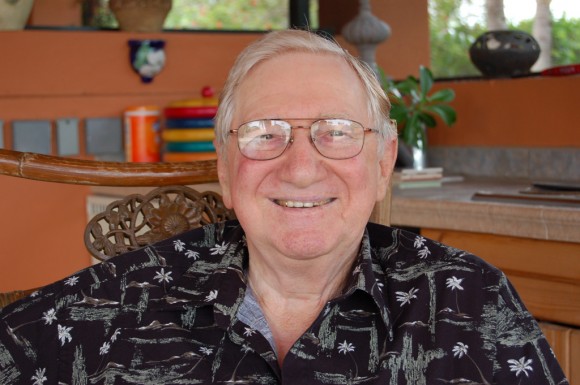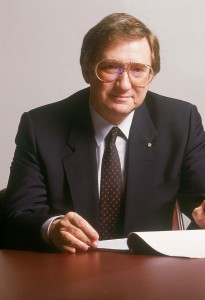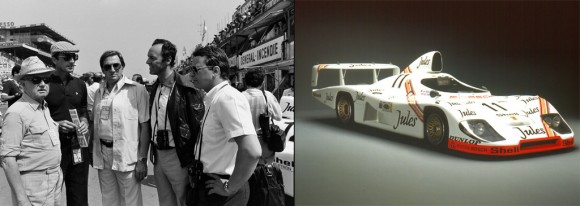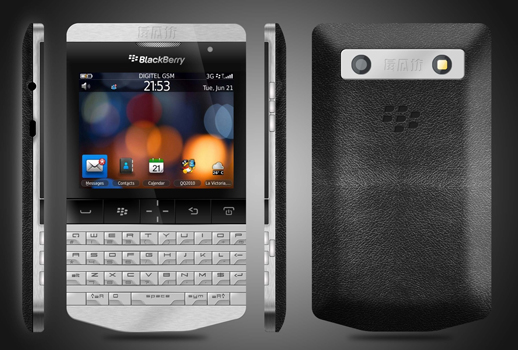
9 Magazine had the opportunity to sit down with Mr. Peter Schutz. Mr. Schutz was the CEO of Porsche AG during a very tumultuous time in Porsche’s history. Mr. Schutz is the man credited with saving the Porsche 911. Read about how that came to be, and about the man himself.
Peter W. Schutz was born in Berlin, Germany on April 20, 1930. After leaving Germany in March of 1939, his family settled in Chicago, Illinois where Peter grew up and received his formal education. Peter received his BS degree in Mechanical Engineering from the Illinois Institute of Technology. From 1947 to 1950, Peter W. Schutz served in the U.S. Marine Corps Reserve and was on active military service with the U.S. Army from 1954 to 1966.
Mr. Schutz served 15 years in various engineering positions at Caterpillar Tractor Co. in Peoria, Illinois. Peter is an experienced pilot and ran a flying school for Bradley University during his years at Caterpillar. Subsequently, he spent 11 years at Cummins Engine Company Inc. in Columbus, Indiana; three years in corporate strategic planning, and eight years as vice-president responsible for sales and service of Truck Engines in the United States and Canada, about $850 million in revenues. In 1978, Mr. Schutz moved to Cologne, West Germany were he assumed responsibility for the world-wide Diesel Engine and Gas Turbine business of Klockner Humboldt Deutz, with revenues that grew to exceed DM 1 Billion per year.
 Peter W. Schutz was president and CEO of Porsche AG, in Stuttgart, West Germany, from January 1981 until January 1988. Porsche was in the midst of its first money-losing year in 1980. Much of the problem was due to falling sales in the U.S. and lackluster acceptance of their new designs, the Porsche 924, and Porsche 928. Porsche removed long-time CEO Ernst Fuhrmann and started looking for a replacement. Although it was never specifically stated, it was widely believed that Mr. Schutz was selected in order to have an American running the company to re-ignite sales in the U.S.
Peter W. Schutz was president and CEO of Porsche AG, in Stuttgart, West Germany, from January 1981 until January 1988. Porsche was in the midst of its first money-losing year in 1980. Much of the problem was due to falling sales in the U.S. and lackluster acceptance of their new designs, the Porsche 924, and Porsche 928. Porsche removed long-time CEO Ernst Fuhrmann and started looking for a replacement. Although it was never specifically stated, it was widely believed that Mr. Schutz was selected in order to have an American running the company to re-ignite sales in the U.S.
During the Schutz tenure, Porsche worldwide sales grew from 28,000 units in 1980/81 to a peak of 53,000 units in 1986. Revenues went from DM 850 million to DM 3.7 billion, with profits after tax growing from DM 12 million to over DM 125 million.
When the U.S. economy suffered a major downturn in 1987, coupled with a dramatic drop in the US-German exchange rate, U.S. street prices of the Porsche lineup increased dramatically. Production for all models dropped to 48,520 cars and U.S. sales, earlier making up over 60% of Porsche sales, dropped to under half of output. In December, Porsche announced that Schutz was being replaced by Heinz Branitzki.
Today, Peter Schutz and Sheila Harris operate their own company, “Harris & Schutz Inc.” In this context, Peter lectures on many aspects of business, management, and marketing techniques in the USA as well as overseas. He is fluent in both English and German, and has spoken extensively in both languages. These appearances include numerous association conferences and conventions, as well as over 600 TEC (The Executive Committee, a world-wide organization of CEOs; named “TEC resource of the year” in 1995) sessions as well as major Universities world-wide. He has also lectured to Corporate and Strategic planning conferences as well as seminars and sales meetings.
Q: What was it like being the CEO of Porsche during this time, and maybe give us a behind the scenes look at the company before and during your tenure as CEO?
A: “One of the main things that was happening, was my predecessor (Ernst Fuhrmann) who was a very good engineer and the father of putting the turbo charger in the 911, and a lot of great technical accomplishments, somehow he had decided that the 911 does not long for this world. That it couldn’t meet noise, emissions, and a lot of other such things and it was going to be discontinued in 1981. I knew nothing about Porsche or really the car business outside of the United States where it was Chevrolet, ford and Chrysler. But I had learned somewhere along the way to listen, and my favorite philosopher is Yogi Berra who once said, ‘You can observe a lot, if you just watch’ well I learned to watch, and what I saw when I got to Porsche was the company in the doldrums and one of the reasons was the planned discontinuance of the Porsche 911. I’d never driven a 911, I had no idea what that was all about. But it wasn’t very difficult to read the customers and the people that work at Porsche. So I went to Prof. Bott’s office, who was the head of Weissach, and on the wall he had a chart of the 928 and the 924 and the planned continuing evolution of those cars – and then the 911 stopped in 1981. I picked up a big crayon on Helmut Bott’s desk, walked over to the wall and extended the 911 line off the chart, on the wall, around the corner, around another corner all the way over to the window. And I asked him, ‘Professor Bott, do we understand each other?’ and he had a grin from ear to ear and he said, ‘Yes, Herr Schutz.’“
Q: Tell us a little bit about some of the products and challenges you were involved with and developed during your time as CEO?
A: “I decided we should make a convertible 911 and I went to see Professor Porsche and shared that thought with him. He said we should have done that five years ago. So, I went to Wiessach and told Mr. Bott that I wanted to make a convertible out of the 911. And I asked him, ‘You know Porsche once had a convertible, the 356, does the man who designed the top and the top mechanism for that car still work for us?’ He said, ‘Yes, that’s a Mr. Bauer, he is sixty years old, and he’s about to retire.’ So I said, ‘Would you get him up here please.’ So he got Mr. Bauer to come to his office and I told Mr. Bauer, ‘I really love your 356 convertible, could you make a convertible for me out of the 911?’ and he said, “Give me five helpers and three months and you will have a convertible.’ That convertible was done on the basis of the Targa, so it didn’t have to do a lot to the body but take the top off. Mr. Bauer designed a top mechanism that we ended up licensing to almost everybody who made convertibles. It was a real piece of work. We put that car into production in eighteen months from that conversation. Something that you just can’t do anymore today. People were telling me that the 911 is great but just too expensive, well we made a convertible out of it, raised the price 20% and they started flying out of the showrooms. They just loved that Convertible. I brought that convertible home and asked my wife Sheila if she would like to drive it, and she said, ‘No.’ I said, ‘Why, what’s the problem?’ She said, ‘Well, first of all, to unlatch that top, it takes too much pressure, and I can’t reach across to unlatch the right side of the top, so I have to get out of the car, walk over there to unlatch it.’ She says, ‘I’ll drive a convertible Porsche when I have one button that I can push, and the top opens.’ Well I went out to Weissach and I told the people, ‘Here is what I want you to do.’ I told them, ‘One button.’ They said, ‘Herr Schutz, that’s not possible. We would need a motor with more torque than anything that is available. ‘ What I learned about the Germans, especially the Porsche engineers, after they get through explaining why what your asking is impossible, then they do it! And sure enough a few weeks later they had invented a new little motor that had the torque to do that. That top was in production forever, that’s the way we did things.”

Q: You were involved with reviving the motorsports program at Porsche and specifically with the win at the 24hrs of LeMans in 1981 with the 936 race car. Tell us a little bit about the reasons for this initiative?
A: “The reason for the initiative was not very clear at the beginning. I needed something with which to get the excitement in the company going again. We had a meeting and I asked them, ‘What’s going on?’ Truth is there was nothing going on. The reason Professor Porsche had hired me is because he just felt that people were not working together. So I had to find something that everyone could get on board with. And since Porsche had a history of racing and I figured this is the one thing that this company does that everybody gets involved in. So that is when I decided after watching a race at Sebring where a 935 won the race. I had never been a part of anything like that, so when I got back to Germany I had a big meeting. I asked them, ‘What is the most important race of the year?’ They said, ‘The 24hrs of LeMans’ and I asked them, ‘What are we doing to participate in that race?’ They said, ‘We are taking a 944 and turbo-charging it. That’s what we’re going enter.’ I said, ‘Fine. What are the chances of winning?’ ‘There is no chance of winning. But we’re broke, and we really can’t design a new car. Besides there is not enough time.’ So that’s when I told them as long as I’m going to be in charge around here, we will never go to any race without the objective of winning because that’s not Porsche. I said, ‘This meeting is adjourned and you will return at ten o’clock tomorrow morning and tell me about your revised plans.’ Now I took a chance. They could have come back and said forget it, there is no way for us to win that race, we don’t have any budget, we don’t have enough time, but that is not what happened. When I told them that I couldn’t solve this problem, and it was up to them to figure it out – that was all over the plant! Within 24 hours everybody was talking about how are we going to do this. Wouldn’t it be great if we could….the operative word is we. The company came together around that project, and that’s when they suggested taking the 936 which had won the race a few years before, but was now technically obsolete, and an engine which we were hoping to go racing at the Indianapolis 500 in America but the company went broke and the program was cancelled – but we saved all the pieces. We can take that engine and a transmission out of a 917 and put all of that into a 936. I had no idea what in the world they were talking about. But they were excited, and the meeting was twice as big as before. All I remember saying was ‘Let’s go racing!’ This turned out to be a much bigger deal than I ever had imagined. Of course, we won. It also gave me an opportunity to take all the union stewards to LeMans so that they could be a part of what was happening. And for the first time in twenty years, Professor Porsche came to that race. So it was a big deal.
Q: What was it like working with Ferry Porsche? Can you give us a few insights about the man himself?
A: “He really became like a father to me. He was a gentle man, he loved the technology, and when we talked, we talked about the cars, not the unions or other stuff. He was an introverted and private man. He and I did a press conference, he didn’t want to do it. I said, ‘Professor you have to do it. In this organization you are God, and I can’t become God at Porsche. But here is the deal. If you become God then I will volunteer to become Moses and I will lead your people to the promise land, but I can’t do it without you.’ We’ll I’ll never forget an interview with a bunch of Americans, you know Motor Trend and Car & Driver, pretty vicious people, they were looking for something. And they asked Professor Porsche, ‘What is your favorite Porsche of all time’ and I could tell that he didn’t know how to answer. So I answered for him. I said, ‘We haven’t built it yet.’ He loved it! I could tell that was in his heart. I really got to know him. As a matter of fact, when I first started, he had an office in ludwigsburg which was the parts department, which was about 3 kilometers outside Stuttgart. He had a little cubby hole over there. And when I got to Porsche, one of the first things I did, I walked across the hall from my office, which was the accounting department. I told them, ‘Folks, pack up your moving.’ I built an office twice as big as mine for Professor Porsche. He was the old man, and he would come to the office at nine o’clock every morning and go home at noon. And when he showed up, I would walk across the hall and we would have coffee and talk.”
I want to thank you very much for your time today Mr. Schutz, and for sharing this information with the readers 9Magazine.
Photos: 9 Magazine, Porsche Archive




